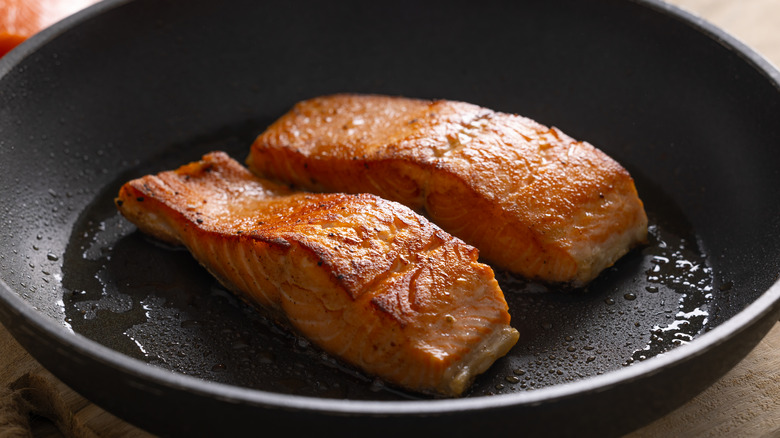The Cooking Method Alton Brown Swears By For King Salmon
To perfect your cooking methods down to a science, there's no better person to look to than Alton Brown. Host of Food Network's famed "Good Eats" and food scientist, his specialized knowledge of ingredients and how they interact when cooked at certain temperatures make him the go-to source for best practices in the kitchen. That's why, when it comes to preparing something as delicate as fish, Brown's method — specifically when it comes to king salmon — is, well, king.
According to Alton Brown's bi-level king salmon filet recipe, it only takes three steps and 20 minutes to perfectly cook this thick piece of fish. You can coat the salmon filet with oil and season it with kosher salt and black pepper, as his recipe suggests, or use other seasonings to upgrade your salmon. Then, Brown's bi-level process will leave you with a perfectly cooked cut of king salmon.
Bi-level refers to the dual cooking method, first searing the salmon on the stovetop to crisp the skin, then flipping it and finishing it off in the oven for a delectable bite without a lot of attention. If the pan is too hot while it's on the stovetop, it could overcook or even burn the fish skin, so keep it at medium. But you can crank the heat on the oven up to 475 degrees Fahrenheit. That might seem steep, but high heat cooks the salmon quickly while locking in its natural juices and preventing the crispy skin from gettin soggy.
Choosing and prepping your king salmon filet
Alton Brown's dual-heat method can get you to the finish line when it comes to cooking king salmon, but without properly purchasing and preparing your filet, it may be a lost cause. Choosing your salmon at the store is equally important as how you cook it. Make sure the fish is fresh by checking the firmness and smell. If it's too soft and emitting a fishy odor, it's best to move on. There are many different cuts of salmon — both wild-caught and farmed — but king salmon, otherwise known as Chinook, is considered to be one of the best. Wild-caught in the North Pacific, this salmon is thick and meaty. Its high fat content enriches the flavor and leaves it with an almost creamy texture. However, taking a wrong turn in the kitchen can leave this cut dry or, worse, fishy.
For this method, Brown suggests you select a skinless filet that's at least 1.5 inches thick. And most important, he recommends removing any lingering pin bones before diving in. Although most store-bought salmon cuts have the bones removed, it's possible for a tiny pin bone to weasel its way into your meal. Check for bones by running your hands over the fish and pressing down lightly, removing any you find with your fingers or kitchen tweezers. Taking these small steps before cooking your fish streamlines the process and, hopefully, you can get it down to a science — just like Brown.

